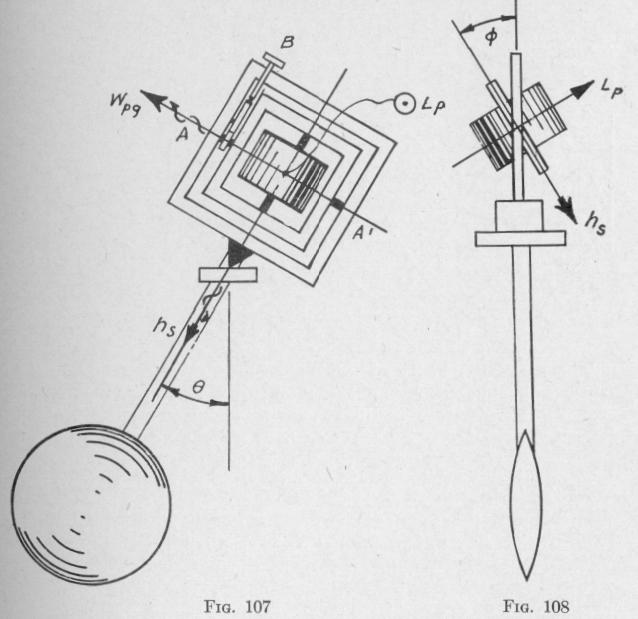136 ANTI-ROLL DEVICES FOR SHIPS
Several schemes have been devised, and some of them developed as far as the initial experimental stage, in which the property of the axle of a spinning gyro-wheel of maintaining its direction in space has been used to control an engine which in turn would move large masses to the higher side of a rolling ship. The magnitudes of the masses that would need to be moved has caused these suggestions to be neglected.
At the present time gyroscopic anti-roll devices are in successful use. They are much used on yachts and also to some extent on
large ships. The action of these devices is based on the fact, proven in Art. 25, that if a body oscillating with a periodic angular motion be acted upon by a torque of the same period, and in the opposite phase to the velocity of the oscillating body, then the system producing the periodic torque will absorb energy from the oscillating body.
§2. The Inactive Type of Gyro Ship Stabilizer
88. The Effect on the Motion of a Swinging Pendulum Produced by an Attached Gyroscope: (a) When the Precession of the Gyro-Axle is Opposed by a Frictional Torque. Experiment. - The pendulum shown in Fig. 106 carries a gyro-wheel mounted so as to have two degrees of rotational freedom. The gyro-wheel spins about a nearly vertical axis through the center of mass of the wheel and attached frame, and it is capable of rotation about a perpendicular axis AA' in the plane of
vibration of the pendulum. For this experiment, the wheel and its supporting frame are lowered till the latter axis is above the center of gravity of the gyro-wheel and its supporting frame. The gyro-frame is prevented from rotating too far out of the plane of vibration of the pendulum by means of stops. A brake B is provided by means of which the precession of the gyro-axle can be opposed by a torque of any desired magnitude.
Release the brake. Set the pendulum into oscillation while the gyro-wheel is spinning. Observe that there is negligible damping of the amplitude of oscillation of the pendulum when the precession is unopposed by the friction brake.
Release the thumbscrew that clamps the gyroscope to the pendulum. Set the pendulum swinging while the wheel is spinning.
THE INACTIVE TYPE OF GYRO S11IP STABILIZER 137
Observe that the gyroscope twists back and forth about the axis of the pendulum as the pendulum oscillates back and forth.
The angular acceleration of the motion of the pendulum is accompanied by a torque or the gyro-frame about an axis parallel to the knife-edge. This torque is maximum when the pendulum is at the end of its swing and is zero when the pendulum is at the
middle of its swing. It produces a precession of the gyro-axle about an axis AA', Fig. 107, perpendicular to the knife-edge. This precession produces a torque Lp on the pendulum about an axis perpendicular to the spin-axle and to the axis of precession. At any instant the magnitude of this torque. is Lp = hswpg, where hs and wpg represent the instantaneous values of the angular momentum of the gyro-wheel about the spin-axis, and the angular velocity of precession, respectively. Hence, when the gyro-axle is passing through its equilibrium position, the gyroscopic torque

